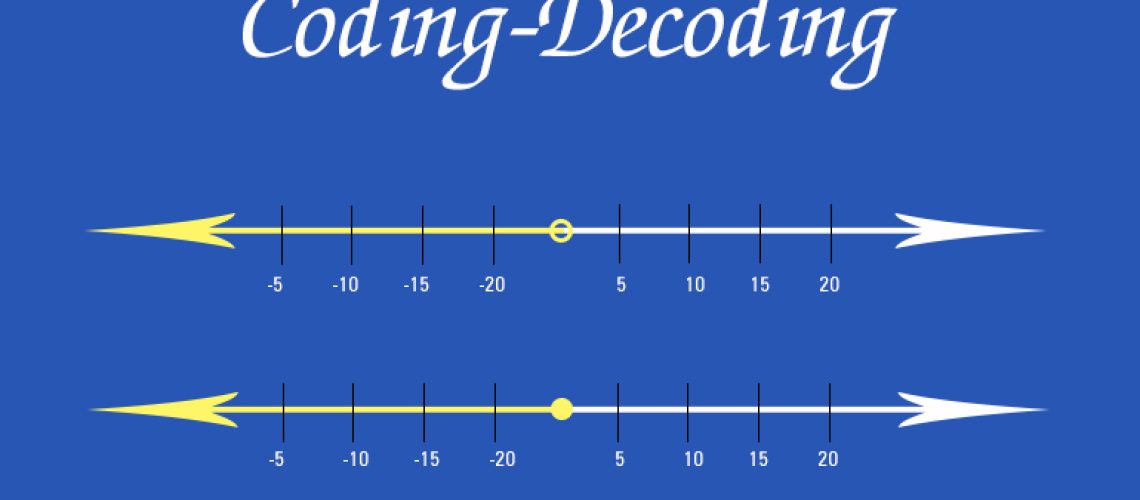As the name suggests, this concept tests your ability to decipher codes. Numbers, alphabets or symbols may be used by the examiner to create a code that will be given in the question itself. Your task is to determine the relationship between the digits of the code and formulate the answer accordingly.
The first step while solving these kinds of questions is to draw a miniature alphabet chart in the logical reasoning section of your question paper. Always remember that there are no marks for rough work. So, kindly do not waste time in drawing elaborate diagrams for any concept of the logical reasoning section.
| A | B | C | D | E | F | G | H | I | J | K | L | M |
| 1 | 2 | 3 | 4 | 5 | 6 | 7 | 8 | 9 | 10 | 11 | 12 | 13 |
| Z | Y | X | W | V | U | T | S | R | Q | P | O | N |
| 26 | 25 | 24 | 23 | 22 | 21 | 20 | 19 | 18 | 17 | 16 | 15 | 14 |
It is essential to draw the table in the manner shown above, as it makes easier for you to associate the numbers with the alphabets in case the question uses a reversed order. Regular practice will help you in memorising the various alphabets with respect to their numerical positions.
Ø TYPE 1: Simple numerical conversions
Example: ATLAS can be coded as 12012119 or 26715268.
Ø TYPE 2: Simple alphabetical conversions
Example: BOX can be coded as YLC. BOOK can be coded as YLLP.
By comparing the two words, it can be visibly noted that Y is used instead of B and so on. The letters in the upper row have been replaced by their corresponding letters from the bottom row and vice-versa.
Ø TYPE 3: Interchanging values
Example: MANGO is coded as 11314157.
Here, the numerical values of the first two and last two alphabets have been interchanged and the code for N is written as it is.
M A N G O
13 1 14 7 15
Ø TYPE 4: Successors and predecessors
Example: APPLE can be coded as BQQMF.
A P P L E
NUMERICAL VALUE: 1 16 16 12 5 +1 +1 +1 +1 +1
= 2 17 17 13 6
ALPHABETICAL VALUE: B Q Q M F
In the above example, every alphabet has been replaced by the very next alphabet or the succeeding alphabet. Similarly, codes in the question may be created using an alphabet preceding the given alphabet.
Ø TYPE 5: Jumbled words
Example: In a certain code, WINDOW is coded as XNIODX. BURROW is coded as CRUORX. How will BUFFER be coded?
W I N D O W
+1 +1
X N I O D X
By following the above pattern, it is understood that the first and last letters of every word have been replaced by the letters succeeding immediately after them and the remaining letters have been interchanged in pairs.
Hence, BUFFER will be coded as CFUEFS.
Ø TYPE 6: Calculative coding
Sometimes, the numerical value of an alphabet may be given in the question itself. In such a case, you are required to solve the question based on the information provided in the question only.
Example: If A=2, B=4 and the value of CAB = 12, what will be the value of AGE?
If CAB= 12, then the value of C= 12 – A – B= 6. It can be observed that the values of alphabets have been replaced by a series of even numbers, or to put it simply, the numerical value of every alphabet has been multiplied by 2.
Following the above pattern, the value of G = 7*2 = 14 and E = 5*2 = 10. Therefore, AGE = 2 + 14 + 10 = 26.
Ø TYPE 7: Phrase coding
This kind of coding involves phrases of 3-4 words each that have no meaning of their own but are translated for you in the question as a phrase in English. Your task is to correlate the translated words to their coded counterparts and find the answer.
Example: “Bing bong bang” means “love your family”. “Sing song bang” means “ Family comes first”. “Bing sing song” means “love comes first”.
What is the code for “your”?
Answer and explanation: “Bing bong bang” “Sing song bang”
“Love your family” “family comes first”
By comparing the above two phrases, it can be observed that only “Bang” and “family” are common. Hence, Bang = family.
Similarly, by comparing the second and third phrases, it can be observed that ‘sing song’ = ‘comes first’ and ‘bing’= ‘love’.
The only words remaining are ‘bong’ and ‘yours’. Hence, Bong = yours.
It must be kept in mind that the aforementioned types are not exhaustive. Students must be mindful of various variations of the types discussed and use their reasoning skills in order to identify the code. However, it is advisable to draw an alpha-numeric chart as shown above for easy and quick reference.
All the best!
YOU CAN REGISTER FOR OUR CORRESPONDENCE COURSES HERE.
You can read more about English HERE
You can read more about Logical Reasoning HERE
You can read more of Current Affairs HERE
You can read more of Legal Reasoning HERE.
You can read more of General Knowledge HERE





